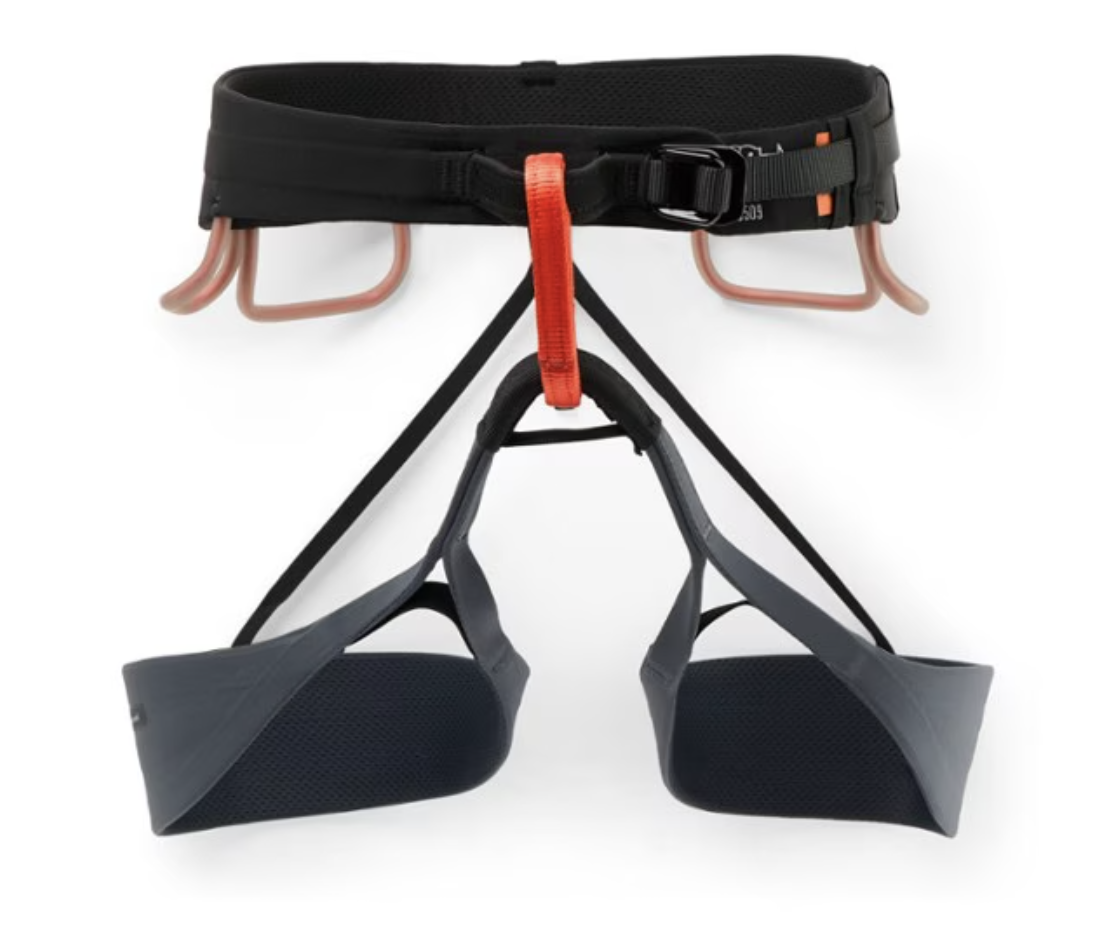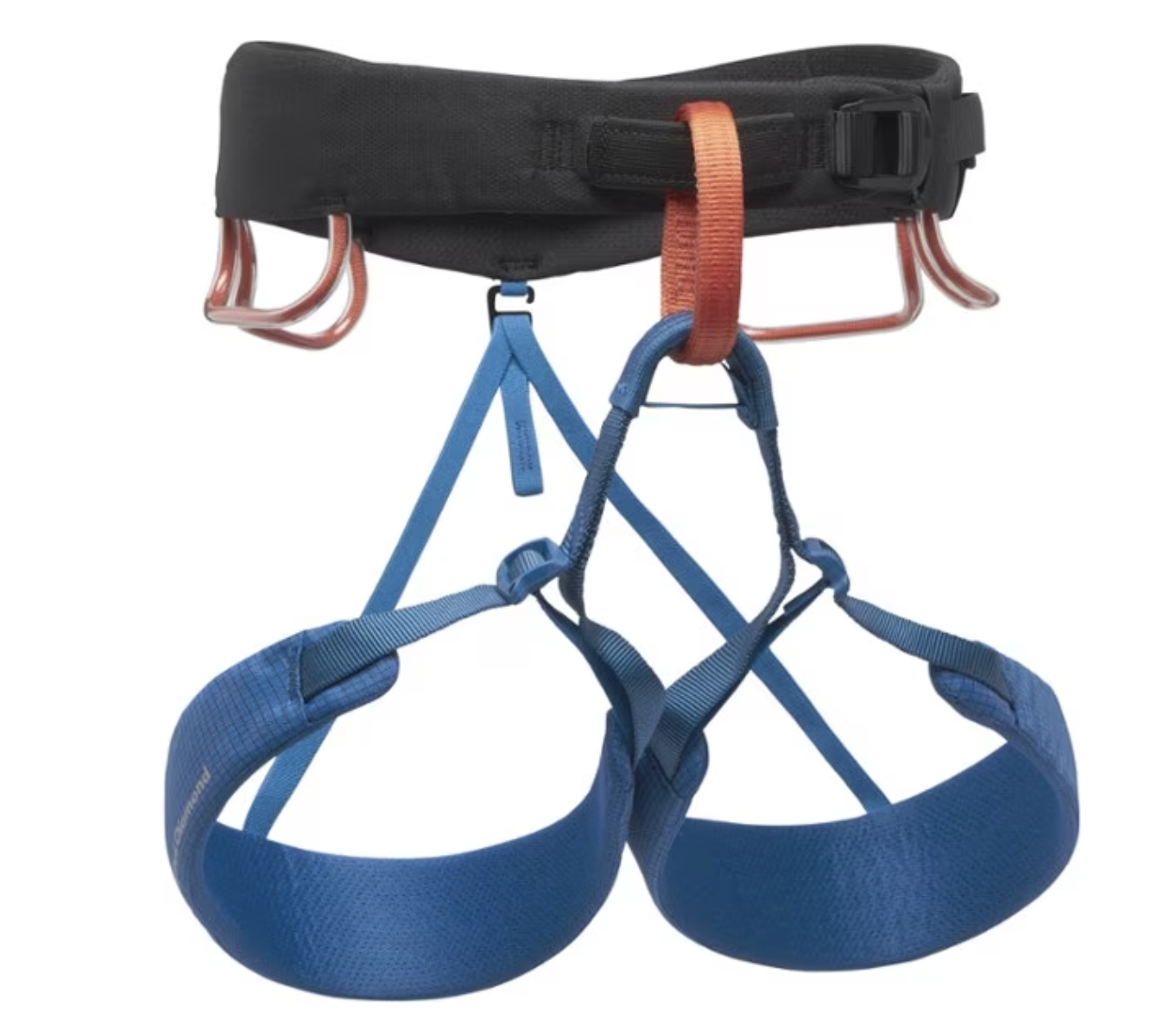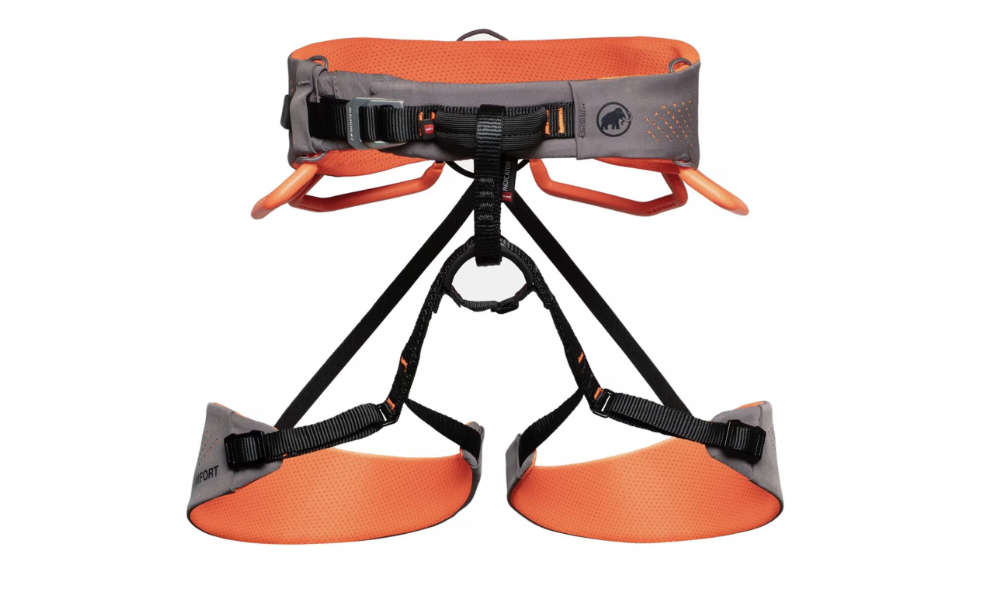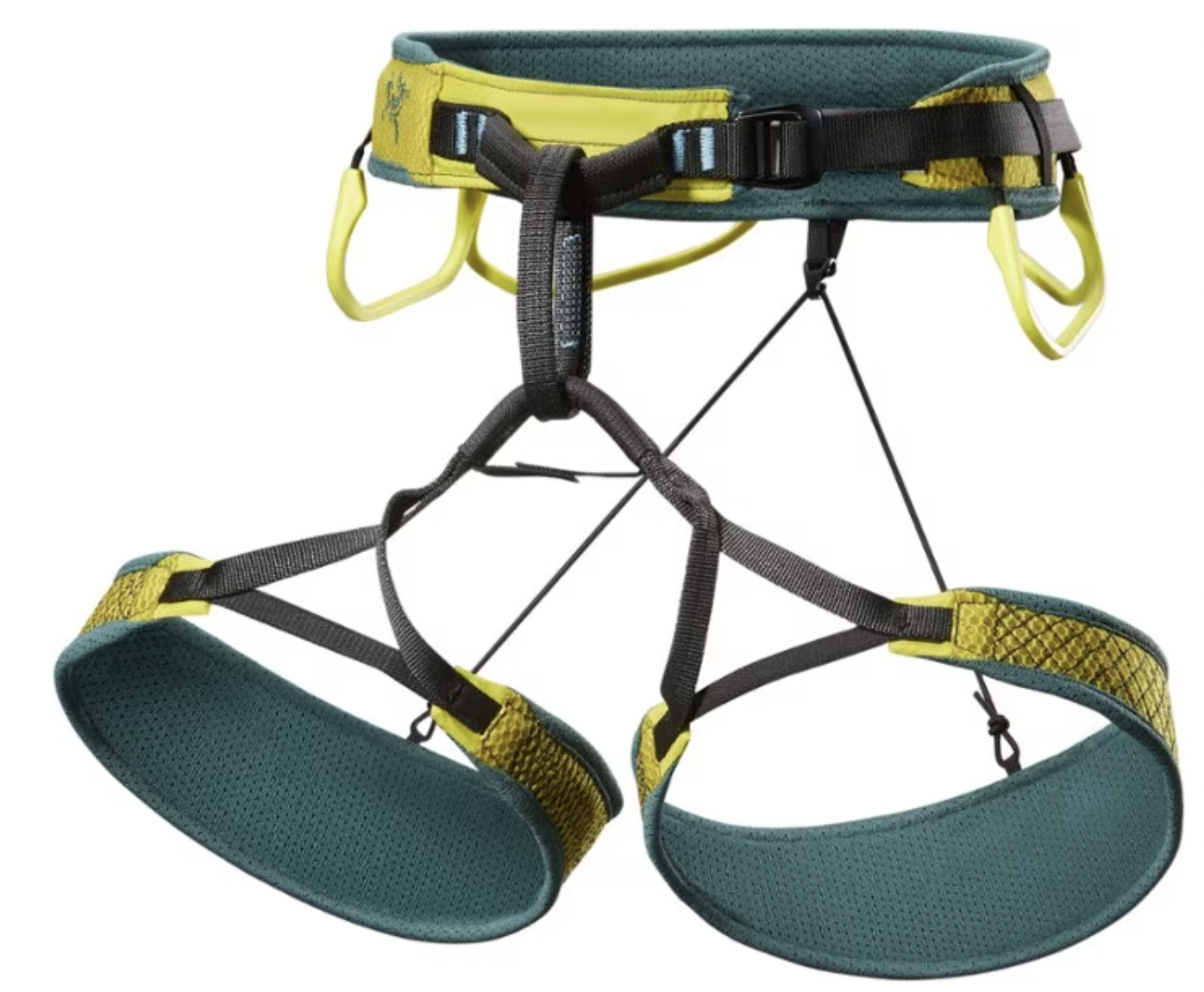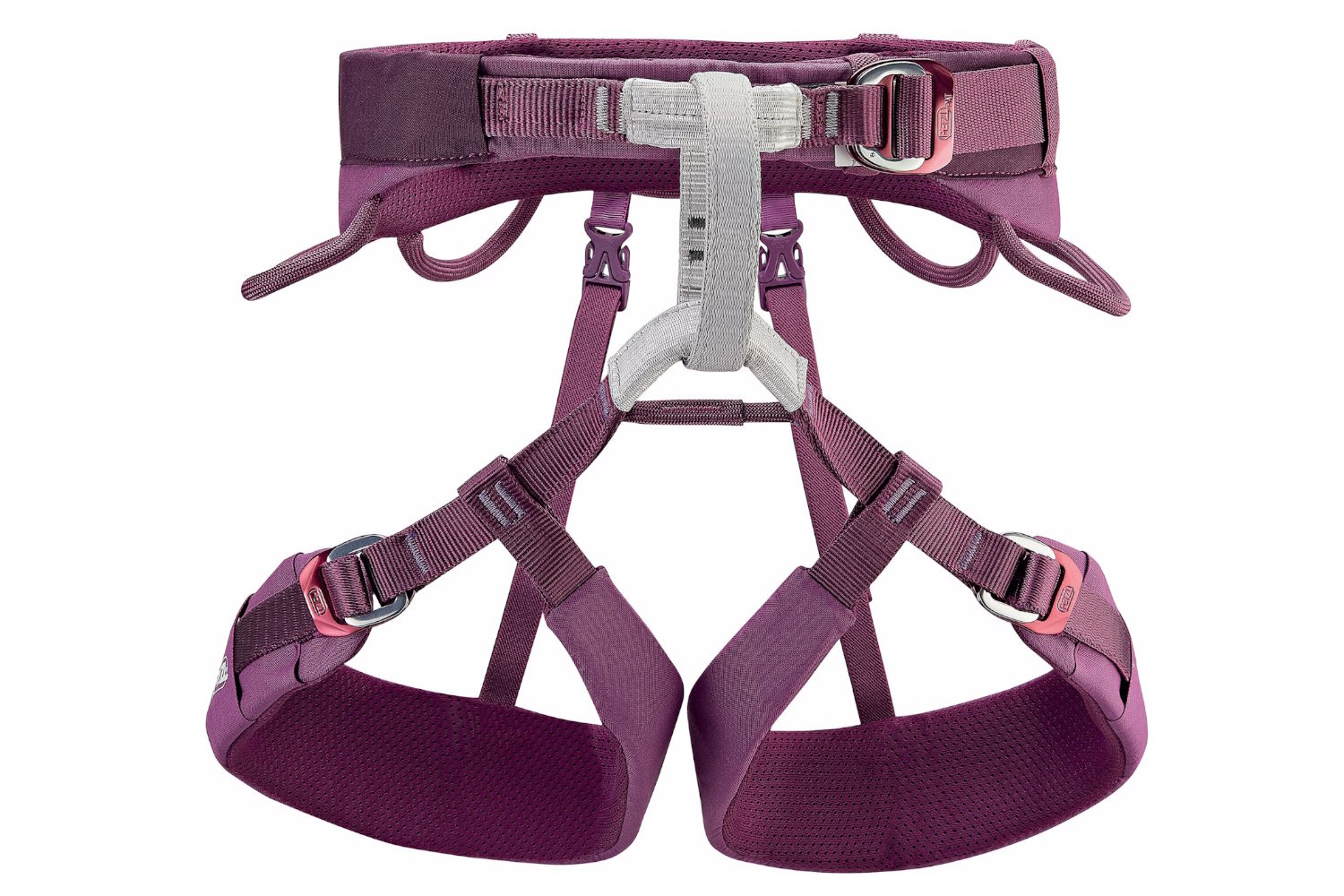At first glance, climbing harnesses may seem simple, but their specific components make a world of difference for a climber’s needs and preferences.
Rest assured, these top picks from our expert gear testers will help you feel safe and secure while also meeting your climbing objectives. We’re here to help you find the best climbing harness for your specific needs.
Our testers include an American Mountain Guides Association-certified rock guide, an intro-to-outdoor rock climbing guide, a former Yosemite Mountain Guide, and a skilled recreational climber. All told, we tested every major women-specific climbing harness on the market.
While testing, our team of experts carefully considered fit, features, durability, and overall value. These harnesses supported our cams, swings, rappels, belays, and rests on a range of North American rock from Canada to Colorado and all over California. Our final list of recommendations represents hundreds of pitches climbed, dozens of hours of hanging at multi-pitch belay stations, and countless after-work gym sessions.
Below, we outline our favorite climbing harnesses for women in a variety of unique categories. If you need more help deciding, check out our Comparison Chart, Price & Value breakdown, and read our Buyer’s Guide for a full rundown of what to consider when purchasing a harness.
Editor’s Note: This guide received an update on November 6, 2024 , where we re-tested some old favorites and added some helpful info about harness pricing and how to get the most bang for your buck. Happy sending!
The Best Women’s Climbing Harnesses of 2025
Black Diamond Solution Harness
- Weight: 11 oz.
- Best for: All-around climbing
- Key features: Fixed leg loops and simple, no-frills design
Pros
- Good value
- Versatile
- Durable
Cons
- Lacks specialty features
Black Diamond Momentum Harness
- Weight: 12.3 oz. (medium)
- Key features: Adjustable leg loops, bullhorn-shaped waist belt
- Best for: Gym climbing, sport climbing
Pros
- Affordable
- Great for beginners
- Quick adjusting leg loops
Cons
- Heavier padding doesn’t breathe well
- Not as packable as other models
- Small, non-rated haul loop
Mammut Comfort Fast Adjust Harness
- Weight: 14.1 oz
- Best for: All-around climbing
- Key Features: Women’s-specific construction, ample gear loops, adjustable leg loops
Pros
- Soft, comfortable, breathable material
- Women’s-specific fit
- Ample, rigid gear loops
- Adjustable leg loops
Cons
- Heavier than other harnesses we’ve tested
- Less structure means less support while hanging
Petzl Sitta Harness
- Weight: 9 oz.
- Key features: Low total weight, easily packable, fixed leg loops
- Best for: Ice or sport climbing, mountaineering
Pros
- Ultralight
- Extremely packable
- Large gear loops and slots for ice tools
Cons
- Very expensive
- Nonadjustable leg loops
- Specialized
Edelrid Helia
- Weight: 13.9 oz.
- Key features: Removable snack/phone storage bag, adjustable leg loops, well-padded and comfortable
- Best for: Trad, multipitch climbing
Pros
- Strategic, comfortable padding placement
- Haul loop is spacious and durable
- Removable zippered bag for stashing essentials
Cons
- Bulky, not a good choice for sport climbing
- Front gear loops are slightly smaller than back gear loops
- Padding of waist belt interferes with space on gear loops
- Expensive
Metolius Safe Tech Deluxe
- Weight: 1 lb., 4 oz.
- Key features: High strength gear and haul loops, wide padded hip belt, dual belay loops
- Best for: Trad, multipitch, big wall climbing
Pros
- Every component has a strength rating of 10 kN
- Double belay loop for less clutter belaying and rappelling
- Comfortable padding
- Made in the USA
Cons
- Old-school, double-back buckle
- Bulky
- Heavy
Arc’teryx Women’s Skaha
- Weight: 10 oz
- Best for: Sport climbing, alpine climbing
- Key Features: Lightweight and breathable, rigid gear loops
Pros
- Lightweight
- Breathable
- Comes in 6 sizes
Cons
- Expensive
- Non-adjustable leg loops (more a preference than a strike against it)
- Weight: 16.6 oz.
- Key features: Adjustable leg loops, plentiful gear capacity
- Best for: Sport and gym climbing
Pros
- Easy to pull on with a nice, big waist buckle
- Comfortable padding on waist and leg loops
- Quick-release leg loops
Cons
- Not the lightest harness
- Small, cord-constructed gear loops more prone to abrasion
- Weight: 8 oz.
- Key features: Load distributing airNET technology, low weight, small gear loops, fixed leg loops
- Best for: High-end sport climbing
Pros
- Ultra-lightweight
- Freedom of movement and breathability
- “Barely there” feeling
Cons
- Expensive
- Non-adjustable leg loops
- Not comfortable for hanging in
- Highly specialized
- Weight: 12.3 ounces
- Key features: Adjustable leg loops, flexible gear loops, split-webbing construction
- Best for: Sport, trad, ice, and gym climbing
Pros
- Extremely strong haul loop
- Two-part webbing construction provides support and comfort
- Fabric of tie-in points changes color when worn down
Cons
- Could use more length in the height of the back padding for support
- Weight: 13.8 oz.
- Key features: Fixed leg loops, comfortable contoured waist belt
- Best for: Sport climbing, gym climbing
Pros
- Light
- Comfortable
- Easy to use
Cons
- Nonadjustable leg loops
- Smaller gear loops than other models
- Weight: 12.7 oz.
- Key features: Adjustable leg loops, movable waist padding
- Best for: Sport, gym climbing
Pros
- Made with Bluesign-certified materials
- Comfortable
- Sliding waist belt for adjustability
Cons
- Only four gear loops
- Small haul loop with low strength rating
- A bit bulky
Women’s Climbing Harness Comparison Chart
| Harness | Price | Weight | Key Features | Best for |
| Black Diamond Solution | $80 | 11.64 oz. | Fixed leg loops, women’s specific rise and fit | Sport, trad, alpine climbing |
| Black Diamond Momentum | $65 | 10.7 oz. | Adjustable leg loops, roomy gear loops, great price | Sport, trad, gym climbing |
| Mammut Comfort Fast Adjust | $110 | 14.1 oz | Women’s-specific construction, ample gear loops, adjustable leg loops | All-around climbing |
| Petzl Sitta | $200 | 9 oz. | Low total weight, easily packable, fixed leg loops | Ice or sport climbing, mountaineering |
| Edelrid Helia | $140 | 13.9 oz. | Removable snack/phone storage bag, adjustable leg loops, well-padded and comfortable | Trad climbing, multipitch climbing |
| Metolius Safe Tech Deluxe | $140 | 1 lb., 4 oz. | High strength gear and haul loops, wide padded hip belt, dual belay loops | Trad, multipitch, big wall climbing |
| Arc’teryx Skaha | $180 | 10 oz. | Lightweight and breathable, rigid gear loops | Sport climbing, alpine climbing |
| Black Diamond Women’s airNET Harness | $170 | 8 oz. | Load distributing airNET technology, low weight, small gear loops, fixed leg loops | High-end sport climbing |
| Petzl Luna | $90 | 16.6 oz. | Adjustable leg loops, plentiful gear capacity | Sport and gym climbing |
| Mammut Ophir 3 Slide | $70 | 12.3 oz. | Adjustable leg loops, flexible gear loops, split-webbing construction | Sport, trad, ice, and gym climbing |
| Petzl Selena | $80 | 13.8 oz. | Fixed leg loops, comfortable contoured waist belt | Sport climbing, gym climbing |
| Edelrid Jayne | $70 | 12.7 oz. | Adjustable leg loops, movable waist padding | Sport climbing, gym climbing |

How We Tested the Best Women’s Harnesses
Our Expert Testers
Miya Tsudome is one of the primary gear testers of this review. A seasoned gear reviewer for over five years, she combines her decade of climbing experience and background as a climbing guide for the Yosemite Mountaineering School to help you make the most informed purchasing decisions for your climbing harness needs.
Miya has climbed El Capitan in Yosemite Valley, and has sport climbed in far-flung destinations like Greece and Spain. While many climbers choose to focus on or prefer one discipline, Miya loves it all. Whether she’s filling up her harness with a heavy rack of trad gear to cast away on splitter cracks in Indian Creek, or wearing a light set of quickdraws for a sport climbing redpoint attempt at her local crag in Bishop, California. This makes her a great authority on what makes or breaks a good climbing harness, as she knows what works and what doesn’t for multiple types of climbing endeavors. She’s also tested categories such as women’s climbing shoes and climbing ropes.
Our Testing Grounds
Living in Bishop, California, on the flanks of the Sierra Nevada mountains, Miya spends all of her free time in a harness. She spent a month with several of the models in our lineup, taking them out for multiple 6+ hour climbing days where she put them to the test.
She went sport climbing in Bishop’s Pine Creek Canyon and Lee Vining’s Tioga Cliff, trad climbing in Tuolumne Meadows, the high-elevation playground of Yosemite National Park, and multipitch alpine climbing in the High Sierra mountains. She feels lucky to live somewhere where she has so much amazing access, and can really put harnesses through the wringer with so many different styles of climbing. It’s important to test a harness in various scenarios, like hanging on a bolt working moves on a sport climbing route, rappelling down long multipitch routes, or taking lead falls, and she did it all.
Our Testing Process
Miya and the other testers on this review spent weeks assessing the comfort, adjustability, fit, weight, and features of the harnesses in this review to help you make the most informed decision for your next climbing harness purchase. It’s crucial to test climbing gear out in real-world scenarios, so we took each harness out on our climbing days over the course of a month to test their capabilities.
To test the comfort of each harness, we made sure to hang at a bolt for a duration of at least 5 minutes to see how supportive they were and how the padding or lack thereof made a difference. Adjustability was determined by loosening and tightening all the cinches and buckles multiple times, making note of whether or not it was easy to do one-handed or not. We made sure to also have our friends try each harness on to account for fit and different body sizes. We made note of whether the non-adjustable leg loop harnesses caused a fit issue or not.
GearJunkie has been testing women’s climbing harnesses since 2021, and stays as current as possible on all the new models hitting the market today. Some of the harnesses in our lineup were previously owned by our lead tester herself, so were not subject to the month long testing process that the other harnesses were. Each harness has been thoroughly reviewed to the GearJunkie standard, and we hope that this is helpful for you when you are making your purchasing decision.
For more info, check out our harness fitting guide.
Buyer’s Guide: How to Choose a Climbing Harness
All body types are unique and have diverse proportions. One climber’s waist might be narrow or boxy while the same person’s quads are built-out or straight. Harnesses don’t come in “one size fits all,” especially the harnesses without adjustable leg loops. Therefore, it’s best to go to a store and try on a variety of harnesses before making your purchase, so you can be sure to find one that fits your body type best.
As you choose a harness, consider selecting one that’s fully adjustable like the Black Diamond Momentum, Petzl Luna, or the Metolius Safe Tech if you plan on climbing in various weather conditions and environments where you may want to add or subtract layers.

Adjustable leg loops can help accommodate layers for cold-weather climbing, and also allow you to dial in the fit and feel of your harness to just the way you like it.
While some people might like snug leg loops, others will prefer them to be looser around their thighs for comfort and mobility. Again, this is all a matter of personal preference, so trying before you buy becomes that much more important.
What Makes a Climbing Harness Women’s-Specific?
Very often, women have uniquely different body shapes than men, which is why many harnesses mostly come in both women’s and men’s versions. Women’s waists tend to be narrower than their hips, with a longer rise between their waist and legs.
Men’s models tend to be geared toward straighter bodies, and those harnesses will sit closer to the hips as a result. The key to finding the right harness for you is to evaluate your body type. If you have a more narrow, straight torso, a men’s harness might actually fit you better. If your body type is more hourglass in shape, then a women’s harness is designed just for you.
Other features that make a harness more female-friendly are easily detachable leg loops, as found in the Petzl Luna, Sitta, and Selena, as well as the Edelrid Helia and the Jayne. With a quick-deploy buckle, you can detach the leg loops and take a squat to use the bathroom without having to take off your whole harness. This is especially nice when on a multipitch climb where taking off your harness is not an option for safety reasons.
Women’s waists tend to be narrower than men’s, while their thighs tend to be larger. This is another thing to consider when purchasing a harness, because harnesses without adjustable leg loops might fit great in the waist but be too small around the thighs, depending on your body type. This is another reason why it’s best to try before you buy.
Different Harnesses for Different Styles of Climbing
Another thing to consider before you buy a new harness is what style of climbing you will mostly participate in. Harnesses vary widely in their weight and features, making some more suitable for certain types of climbing than others.

Sport Climbing
If you are primarily a sport climber, then you will want a lighter, more minimalist harness, as you only need enough space on your gear loops for quick draws, and don’t want to be weighed down when you are going for your hard redpoint attempts.
The lightest harnesses we tested are the Black Diamond airNET and the Petzl Sitta, which are good choices for the most serious sport climbers. But the Black Diamond Solution, Petzl Selena, and Edelrid Autana are all great sport climbing harness options as well.
Trad Climbing
You will inevitably be carrying a lot more gear on your harness when trad climbing versus sport climbing, and therefore it is a good idea to get a harness with big, durable gear loops, with five loops instead of four being preferable, and a harness that is comfortable and supportive.
The Black Diamond Momentum is a great entry-level trad climbing harness, with its rigid, plastic-coated gear loops that are durable and abrasion-resistant. The Edelrid Helia and the Metolius Safe Tech are also excellent choices for the psyched multipitch trad climber, with the Helia having five gear loops for ultimate gear racking and a pouch for storing essentials on your waist.
The Safe Tech has all its components strength rated up to 10 kN, making it the safest harness in the lineup and therefore great for big wall trad or aid climbing.
Gym Climbing
If you find yourself more of an indoor plastic grabber, a beginner climber, or a top rope hero, then it’s best to buy a harness that is inexpensive and easy to use. You won’t need the frills of ice screw attachments, haul loops, or double belay loops. Instead, look for a comfortable, functional harness like the Black Diamond Momentum, Petzl Luna or Selena, or Edelrid Jayne.
These harnesses come at a lower price point, are comfortable, and are well-equipped to stay in the gym or go to the crag. Until you need a more specialized harness, any of the above options will do just the trick.
Ice Climbing or Mountaineering
Lastly, if you prefer cold-weather or big mountain pursuits, there are harnesses out there that might be better suited to your specialty than others. You want a harness that is lightweight and packable, as you will already be carrying and wearing more gear.
You also want a harness that has attachments for ice screws or loops for ice tools, a good haul loop for extra gear or a tagline, and a harness that is flexible enough to move well with your body when you are wearing bulky layers.

The Petzl Sitta is our top choice in this category, as it meets all the above requirements, plus it’s light enough to also function as a great sport climbing harness, justifying its high price tag.
Parts of a Climbing Harness
The basic parts of every climbing harness are the waist loop, leg loops, belay loop, and gear loops. Every harness on our list includes these fundamental features, no matter which climbing discipline it’s designed for. Beyond the essentials, harnesses may also have additional features such as a haul loop and ice clipper slots.
Waist and Leg Loops
The waist loop of a climbing harness should fit snugly around your waist and sit just above your hip bones. Most waist loops can be adjusted using a system of webbing and buckles. Many harnesses come with a similar buckle adjustment system on each leg loop.
Harnesses with fixed leg loops are usually built for high-end sport climbing. It’s very important that your waist and leg loops fit properly, and we recommend trying a harness on before purchasing.
Belay Loop
The belay loop is made of very strong nylon or Dyneema webbing and connects the waist loop to the leg loops. While belaying or rappelling, this loop is used to attach yourself to the rope and the greater climbing system.
Lightweight harnesses for sport climbing or mountaineering will have thinner belay loops, while all-around and trad climbing harnesses will have thicker loops. Many big-wall harnesses, like the Metolius Safe Tech, include two belay loops for extra versatility. Because your belay loop is a key part of the climbing system, you should check it regularly for wear.

Gear Loops
Every harness will include at least two gear loops where you can conveniently hang items including quickdraws, cams, a jacket, a water bottle, and so on. The more gear-intensive and technical the climbing, the more gear loops you’ll need.
A harness with fewer than four gear loops is a specialty item and is probably designed for high-end sport climbing or mountaineering. Most all-around and entry-level harnesses come with four gear loops, which is plenty for gym climbing and single-pitch climbing.
For multipitch climbing, the addition of a fifth gear loop or haul loop is often useful. Big-wall climbing requires lots of gear, and many big-wall harnesses have more than four gear loops.
Haul Loop
A haul loop is a small attachment point located at the back of a climbing harness. This feature is not necessary for gym climbing or single-pitch climbing.
For multipitch or big-wall climbing, look for a haul loop rated to full strength so you can use it to haul heavy loads. While actively climbing, a haul loop can be a convenient place to store an extra layer or a water bottle.
Ice Clipper Slots
Harnesses with ice clipper slots are specifically designed for ice climbing. They’re primarily used to carry ice screws.

Materials and Construction
As of 2025, climbing harnesses have evolved into lightweight, comfortable, and exceptionally strong pieces of gear. Still, as new materials and technology come to the forefront, harnesses continue to improve. In today’s market, there are two primary types of harness construction: foam and split webbing.
Foam Harnesses
Foam harnesses are built on a single piece of high-strength webbing embedded in layers of cushy foam. While the webbing gives this kind of harness its load-bearing ability, the foam provides support and comfort.
A well-constructed foam harness effectively disperses your weight while falling or hanging. Foam offers ample padding, and it is still the standard for harnesses built for comfort, including most entry-level and big-wall harnesses. On this list, the Petzl Selena is a great foam harness.
However, foam and webbing construction does have some disadvantages. Foam is an insulator and does not breathe well. In warm weather, these harnesses can feel hot and sweaty.
Foam also wears out over time, and the more you climb in it, the less comfortable it will become. For experienced sport and trad climbers, foam harnesses are no longer the best option on the market.
Split Webbing Harnesses
Though foam and webbing harnesses have been the standard for several decades, more and more climbers are turning to split webbing harnesses.
Instead of a single piece of webbing covered by foam, split webbing harnesses feature a web-like matrix of high-strength materials. By spreading out the load-bearing materials, these harnesses are able to distribute pressure more evenly.
On split webbing harnesses, very little padding is required to create a comfortable fit. Split webbing harnesses tend to last longer than foam options, and many climbers find they offer a comfort advantage too.
The tradeoff is split webbing harnesses are considerably more expensive. However, split webbing is clearly the future of harness technology, and many of our favorite harnesses fit into this category. The Black Diamond airNET is a high-quality split webbing harness.
Harness Sizing
It’s very important that your climbing harness is properly fitted. Ultimately, the best way to find a good fit is to try a harness on before purchasing. Every harness and every person has a unique shape and dimensions, and the process of identifying the perfect match can involve some trial and error.
A properly fitted harness will feel snug and sit just above the hips. The harness should be tight but not uncomfortably so. It’s okay to be able to fit a finger or two between your body and the harness.
The leg loops should sit semi-snugly around your mid-thigh. It’s good to maintain a little wiggle room in your leg loops, as they can cut off circulation if they are too tight. While all harnesses include adjustable waist loops, not all include adjustable leg loops.
If you plan to climb in alpine conditions where you’ll need to change your lower body layers often, adjustable and/or removable leg loops are a must. Leg loops come with thin elastic straps that attach to the waist loop along the backside of the thighs. These are often releasable for easy bathroom breaks.
Durability
Depending on what kind of climbing you do — and how often you do it — a harness can last anywhere from a few months to multiple years. Because sport climbing tends to involve less contact between your harness and the rock, sport harnesses can be relatively thin.
Trad and aid climbing involve techniques such as offwidth and chimneying, which require direct contact between your body and the rock. Most trad and aid harnesses are made from burly materials. For example, the Black Diamond airNET is built with an extra abrasion-resistant outer material.
Though the ultralight innovations sweeping the climbing market are exciting, it’s important to remember lighter materials do generally come with a decrease in durability. If you choose to buy a super low-profile model, you should also be aware it probably won’t last as long as more robust options.

When to Retire Your Harness
Just like a climbing rope, a harness should be regularly inspected for signs of wear. Pay extra attention to the weight-bearing components, including the tie-in points, belay loop, waist loop, and leg loops. Look carefully for fraying, fuzziness, or any signs of abrasions. The belay loop or tie-in points are usually the first parts of a harness to wear out.
If you’re not sure whether your harness needs to be retired, look up the manufacturer’s instructions for care and maintenance. Generally, we advise conservative decisions regarding whether a harness is still safe to use. If you have doubts about the condition of your harness, purchase a replacement.
Weight
Whether you’re wearing it or hauling it in your pack, you’re going to spend a lot of time carrying your harness around. Lightweight harnesses are generally associated with increased performance.
For entry-level climbers, weight is not as important as comfort. However, for climbers working to push themselves and improve — especially in the sport climbing discipline — minimal weight is preferred.
Though lightweight harnesses work great for sport climbing and mountaineering, other disciplines call for something a little heavier. Big wall harnesses, with their numerous gear loops and maximal comfort, are rightfully heavy.
On this list, we’ve included incredibly light harnesses like the Black Diamond airNET, which weighs 9.2 ounces. On the other end of the spectrum, we also recommend the thick and burly Metolius Safe Tech Deluxe, which weighs well over a pound.
Price & Value
Climbing harnesses can range in price from anywhere between $65 to $200. The harnesses in our review fall mostly within the middle of that range, giving you a variety of options so you can find something that works best for your needs.
Budget
The budget category for harnesses ranges between $65-$70. Don’t mistake “budget” for cutting corners though, as these harnesses are just as safe and well-made as anything more expensive. Our favorite harness in this category is the Black Diamond Momentum ($65), which does a brilliant job at combining utility with weight and cost. Comfortable, simple, and great for multiple climbing disciplines, you can’t go wrong with this harness. Another good all-arounder is the Mammut Ophir 3 Slide ($70), though we still prefer the Momentum overall for its comfort and versatility. When you buy a budget harness, you sacrifice some qualities like specialization and weight-savings that you will find in mid-tier and more premium harnesses, but these still remain a great choice for the casual climber.
Mid-Tier
Mid-tier harnesses will range in price from $80-$110 and will cover the bases for most climbers. Our top pick, the Black Diamond Solution, is only $80 and is one of the best harnesses we’ve ever worn, proving you don’t have to break the bank for a truly great piece of gear. Sleek, comfortable, and lightweight, this harness is made with a women’s-specific rise for even more comfort and back support while hanging. Another great mid-tier pick is the Petzl Luna ($90), which although a bit more on the heavy side, comes with an ample 5th gear loop, detachable leg loops, and nice smooth buckles for dialing in your fit. Mid-tier harnesses are typically great all-arounders and will suit the needs of anyone who isn’t looking for something super specific, which you will typically have to shell out more cash for.
Premium
Premium harnesses typically cost between $140-$200, and will be more specialized than your budget or mid-tier finds. A good example of this is the Petzl Sitta ($200), the most expensive harness in our review, which is ultra-lightweight and made for either performance climbing or mountaineering. This harness is made with a more intricate design so that it remains comfortable while being so light in weight, has slots for ice tools, and is extremely flexible and packable, all while still having ample gear loops for everything you need. The Metolius Safe Tech Deluxe ($140) is another good example of a more specialized harness, as it has two belay loops, four very large reinforced gear loops, and is foam-lined with fleece for comfort. This makes it a great choice for trad multi-pitch and big wall climbing. Most climbers will be happy with a harness from our mid-tier category, but those looking for more specialized features will have to pay a more premium price.
Frequently Asked Questions
Men and women have different body shapes and many harnesses are made to accommodate those differences. Women’s-specific harnesses will typically have a narrower waist belt and a longer distance between the waist belt and leg loops.
This allows the harness to sit higher on the waist, whereas a men’s harness will sit closer to the hips. Women’s-specific harnesses will also typically come in different color schemes than men’s-specific harnesses. Depending on your body type, you should buy a harness that fits you best, regardless of gender.
A climbing harness should fit a woman snugly around the waist, above the hips. This is because women tend to have a lower center of gravity than men, and a harness is the safest and most secure when it fits well around the waist.
Leg loops should be snug but not overly loose or overly tight. This provides the most support and mobility for comfort and safety.
The best way to determine what size climbing harness to get is to try one on in a store. Climbing harnesses come in all shapes and sizes, and one brand’s size small is not another brand’s size small. You can also look up the harness’s specs on each brand’s website, where measurements are typically listed.
Taking your own measurements into account, you will be able to determine what size you might want to buy. Another thing to consider is what type of climbing you will be doing. If you are doing any ice climbing or mountaineering, or climbing in variable weather or in different seasons, you might want to size up to accommodate extra layers.

Sport Climbing Gear List: 12 Essentials for Beginners
Sport climbing is one of those hobbies that’s mostly free and extremely accessible once you own the gear. But, figuring out what gear to initially purchase can be challenging.

The Best Women’s Climbing Shoes of 2025
We tested and reviewed the best women’s climbing shoes of 2024, including picks from La Sportiva, SCARPA, and more.

